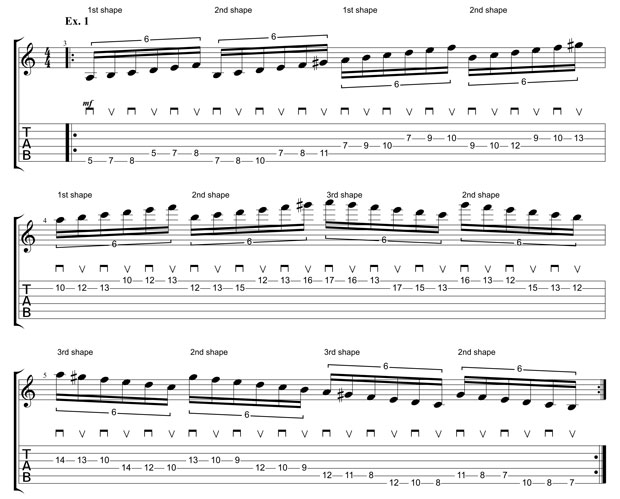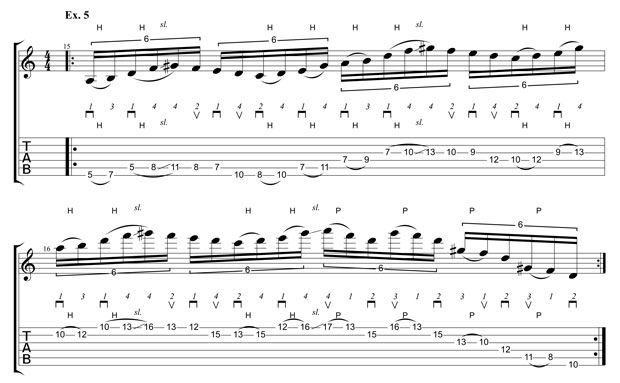Guitar Strength: A Guide to Shape-Shifting, Part 2

In the last installment of Guitar Strength, I showed you how to take a simple two-string fretboard shape and move it across three octaves in order to create long, fluid lines that traverse a wide range.
This time around, I’ll demonstrate how to take the technique to the next level by combining “neighboring” shapes.
Example 1, based in A Harmonic Minor (A,B,C,D,E,F,G#), takes two consecutive six-note scale shapes and repeats them over three octaves. After ascending through three octaves with the first two shapes, the lick continues into a third shape, which creates a new set of shapes (the third and the second) for the descent through the pattern.
Note how adding the second shape helps smooth the intervallic transition from octave to octave and allows for a more fluid physical shift from position to position (since the 2nd shape is always in essentially the same position as the next octave of the first shape going up and the third shape coming down).
As a bonus, sequencing the scale in this fashion has a very “wave-like” melodic flow relative to the beat and is also kick-ass practice for mastering the transitions between “inside” and “outside” picking (More on that here).

After you’ve run through the above shapes, give Example 2 a try. This slinky legato journey through the same shapes demonstrates how easy it can be to manipulate the combining of shapes to dramatic effect. Pay close attention to the "hammer-ons from nowhere" (More on those here) that elongate the legato phrases and to the “omitted” note from the pattern in the latter half of each bar.

Examples 3a and 3b take two of the triad arpeggios found inside the previous shapes (B Diminished and C Augmented) and combine them across three octaves.
All the latest guitar news, interviews, lessons, reviews, deals and more, direct to your inbox!
Example 3a uses economy picking while Example 3b uses a down-up-hammer motion to execute each three-note group. Be sure to see and feel each three-note arpeggio group as its own position and shift your hand accordingly. This has the flow of arpeggios while imparting the ripping qualities of a well-designed scalar line. (Fellow theory geeks: Check out how a third arpeggio, G#dim7, forms from the last note of the C+ going into the Bdim triad. Try this with other “neighboring arpeggios” and you’ll be amazed at the results!)


Adding another note from each of the shapes we began with to create more complex arpeggios (Bm7b5 and C+ add 9), Example 4 is a pure shredder! Experiment with different fingerings for your own maximum efficiency, making sure to shift positions or fingerings in successive four-note groups.

Finally, Example 5 combines many of the attributes of the above examples into a sprawling, exotic, diminished-flavored run. I recommend practicing the first half of the first bar in a non-stop loop to get the pattern, picking and fingering down perfectly before continuing through the remaining two octaves.
The lick wraps up by shifting gears with the picking while shifting through three octaves with a G#dim7 turnaround. Also be sure to experiment with different combinations of picking and legato throughout to find the most effective and expressive means of performing the lick in your own way.

Approach the examples by practicing them slowly and methodically for a few minutes each, being sure your performance is clean, concise, strong, clear and in rhythm. Once you get the patterns and phrasings down, I’m confident you’ll be able to get these up to breakneck speed in a remarkably short amount of time. Happy shredding!
Scott Marano has dedicated his life to the study of the guitar, honing his chops at the Berklee College of Music under the tutelage of Jon Finn and Joe Stump and working as an accomplished guitarist, performer, songwriter and in-demand instructor. In 2007, Scott developed the Guitar Strength program to inspire and provide accelerated education to guitarists of all ages and in all styles through state-of-the-art private guitar lessons in his home state of Rhode Island and globally via Skype. Learn more at GuitarStrength.com.
Scott Marano has dedicated his life to the study of the guitar, honing his chops at the Berklee College of Music under the tutelage of Jon Finn and Joe Stump and working as an accomplished guitarist, performer, songwriter and in-demand instructor. In 2007, Scott developed the Guitar Strength program to inspire and provide accelerated education to guitarists of all ages and in all styles through state-of-the-art private guitar lessons in his home state of Rhode Island and globally via Skype.
